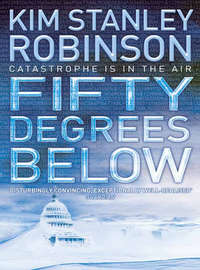
Полная версия
Green Mars
A few months after that a third mirror, much smaller than the soletta, spun down into the highest reaches of the Martian atmosphere. It was another lens made of circular slats, and looked like a silver UFO. It caught some of the light pouring down from the soletta, and focused it still further, into points on the surface of the planet that were less than a kilometre across. And it flew like a glider over the world, holding that concentrated beam of light in focus, until little suns seemed to bloom right there on the land, and the rock itself melted, turning from solid to liquid. And then to fire.
The underground wasn’t big enough for Sax Russell. He wanted to get back to work. He could have moved into the demi-monde, perhaps taken a teaching position at the new university in Sabishii, which ran outside the net and covered many of his old colleagues, and provided an education for many of the children of the underground. But on reflection he decided he didn’t want to teach, or remain on the periphery—he wanted to return to terraforming, to the heart of the project if possible, or as close as he could get to it. And that meant the surface world. Recently the Transitional Authority had formed a committee to co-ordinate all the work on terraforming, and a Subarashii-led team had got the old synthesis job that Sax had once held. This was unfortunate, as Sax didn’t speak Japanese. But the lead in the biological part of the effort had been given to the Swiss, and was being run by a Swiss collective of biotech companies called Biotique, with main offices in Geneva and Burroughs, and close ties with the transnational Praxis.
So the first task was to insinuate himself into Biotique under a false name, and get himself assigned to Burroughs. Desmond took charge of this operation, writing a computer persona for Sax similar to the one he had given to Spencer years before, when Spencer had moved to Echus Overlook. Spencer’s persona, and some extensive cosmetic surgery, had enabled him to work successfully in the materials labs in Echus Overlook, and then later in Kasei Vallis, the very heart of transnat security. So Sax had faith in Desmond’s system. The new persona listed Sax’s physical ID data—genome, retina, voice, and finger prints—all slightly altered, so that they still almost fit Sax himself, while escaping notice in any comparative matching searches in the nets. These data were given a new name with a full Terran background, credit rating, and immigration record, and a viral subtext to attempt to overwhelm any competing ID for the physical data, and the whole package was sent off to the Swiss passport office, which had been issuing passports to these arrivals without comment. And in the balkanised world of the transnat nets, that seemed to be doing the job. “Oh yeah, that part works no problem,” Desmond said. “But you First Hundred are all movie stars. You need a new face too.”
Sax was agreeable. He saw the need, and his face had never meant anything to him. And these days the face in the mirror didn’t much resemble what he thought he looked like anyway. So he got Vlad to do the work on him, emphasising the potential usefulness of his presence in Burroughs. Vlad had become one of the leading theoreticians of the resistance to the Transitional Authority, and he was quick to see Sax’s point. “Most of us should just live in the demi-monde,” he said, “but a few people hidden in Burroughs would be a good thing. So I might as well practise my cosmetic surgery on a no-lose situation like yours.”
“A no-lose situation!” Sax said. “And verbal contracts are binding. I expect to come out handsomer.”
And for a wonder he did, although it was impossible to tell until the spectacular bruising went away. They capped his teeth, puffed his thin lower lip, and gave his button nose a prominent bridge, and a little bit of a bend. They thinned his cheeks and gave him more of a chin. They even cut some muscles in his eyelids so that he didn’t blink so often. When the bruises went away he looked like a real movie star, as Desmond said. Like an ex-jockey, Nadia said. Or an ex-dance instructor, Maya said, who had faithfully attended Alcoholics Anonymous for many years. Sax, who had never liked the effects of alcohol, waved her off.
Desmond took photos of him and put them in the new persona, then inserted this construct successfully into the Biotique files, along with a transfer order from San Francisco to Burroughs. The persona appeared in the Swiss passport listings a week later, and Desmond chuckled when he saw it. “Look at that,” he said, pointing at Sax’s new name. “Stephen Lindholm, Swiss citizen! Those folks are covering for us, there’s no doubt about it. I’ll bet you anything they put a stopper on the persona, and checked your genome with old print records, and even with my alterations I bet they figured out who you really are.”
“Are you sure?”
“No. They aren’t saying, are they? But I’m pretty sure.”
“Is it a good thing?”
“In theory, no. But in practice, if someone is on to you, it’s nice to see them behaving as a friend. And the Swiss are good friends to have. This is the fifth time they’ve issued a passport to one of my personas. I even have one myself, and I doubt they were able to find out who I really am, because I was never ID’d like you folks in the First Hundred. Interesting, don’t you think?”
“Indeed.”
“They are interesting people. They have their own plans, and I don’t know what they are, but I like the look of them. I think they’ve made a decision to cover for us. Maybe they just want to know where we are. We’ll never know for sure, because the Swiss dearly love their secrets. But it doesn’t matter why when you’ve got the how.”
Sax winced at the sentiment, but was happy to think that he would be safe under Swiss patronage. They were his kind of people—rational, cautious, methodical.
A few days before he was going to fly with Peter north to Burroughs, he took a walk around Gamete’s lake, something he had rarely done in his years there. The lake was certainly a neat bit of work. Hiroko was a fine systems designer. When she and her team had disappeared from Underhill so long ago, Sax had been quite mystified; he hadn’t seen the point, and had worried that they would begin to fight the terraforming somehow. When he had managed to coax a response out of Hiroko on the net, he had been partly reassured; she seemed sympathetic to the basic goal of terraforming, and indeed her own concept of viriditas seemed just another version of the same idea. But Hiroko appeared to enjoy being cryptic, which was very unscientific of her; and during her years of hiding she had indulged herself to the point of information damage. Even in person she was none too easy to understand, and it was only after some years of coexistence that Sax had become confident that she too desired a Martian biosphere that would support humans. That was all the agreement he asked for. And he could not think of a better single ally to have in that particular project, unless it was the chairperson of this new Transitional Authority committee. And probably the chair was an ally too. There were not too many opposed, in fact.
But there on the beach sat one, as gaunt as a heron. Ann Clayborne. Sax hesitated, but she had already seen him. And so he walked on, until he stood by her side. She glanced up at him, and then stared out again at the white lake. “You really look different,” she said.
“Yes.” He could still feel the sore spots in his face and mouth, though the bruises had cleared up. It felt a bit like wearing a mask, and suddenly that made him uncomfortable. “Same me,” he added.
“Of course.” She did not look up at him. “So you’re off to the overworld?”
“Yes.”
“To get back to your work?”
“Yes.”
She looked up at him. “What do you think science is for?”
Sax shrugged. It was their old argument, again and always, no matter what kind of beginning it had. To terraform or not to terraform, that is the question … He had answered the question long ago, and so had she, and he wished they could just agree to disagree, and get on with it. But Ann was indefatigable.
“To figure things out,” he said.
“But terraforming is not figuring things out.”
“Terraforming isn’t science. I never said it was. It’s what people do with science. Applied science, or technology. What have you. The choice of what to do with what you learn from science. Whatever you call that.”
“So it’s a matter of values.”
“I suppose so.” Sax thought about it, trying to marshal his thoughts concerning this murky topic. “I suppose our … our disagreement is another facet of what people call the fact–value problem. Science concerns itself with facts, and with theories that turn facts into examples. Values are another kind of system, a human construct.”
“Science is also a human construct.”
“Yes. But the connection between the two systems isn’t clear. Beginning from the same facts, we can arrive at different values.”
“But science itself is full of values,” Ann insisted. “We talk about theories with power and elegance, we talk about clean results, or a beautiful experiment. And the desire for knowledge is itself a kind of value, saying that knowledge is better than ignorance, or mystery. Right?”
“I suppose,” Sax said, thinking it over.
“Your science is a set of values,” Ann said. “The goal of your kind of science is the establishment of laws, of regularities, of exactness and certainty. You want things explained. You want to answer the whys, all the way back to the Big Bang. You’re a reductionist. Parsimony and elegance and economy are values for you, and if you can make things simpler that’s a real achievement, right?”
“But that’s the scientific method itself,” Sax objected. “It’s not just me, it’s how nature itself works. Physics. You do it yourself.”
“There are human values imbedded in physics.”
“I’m not so sure.” He held out a hand to stop her for a second. “I’m not saying there are no values in science. But matter and energy do what they do. If you want to talk about values, better just to talk about them. They arise out of facts somehow, sure. But that’s a different issue, some kind of sociobiology, or bioethics. Perhaps it would be better just to talk about values directly. The greatest good for the greatest number, something like that.”
“There are ecologists who would say that’s a scientific description of a healthy ecosystem. Another way of saying climax ecosystem.”
“That’s a value judgement, I think. Some kind of bioethics. Interesting, but …” Sax squinted at her curiously, decided to change tack. “Why not try for a climax ecosystem here, Ann? You can’t speak of ecosystems without living things. What was here on Mars before us wasn’t an ecology. It was geology only. You could even say there was a start at an ecology here, long ago, that somehow went wrong and froze out, and now we’re starting it up again.”
She growled at that, and he stopped. He knew she believed in some kind of intrinsic worth for the mineral reality of Mars; it was a version of what people called the land ethic, but without the land’s biota. The rock ethic, one might say. Ecology without life. An intrinsic worth indeed!
He sighed. “Perhaps that’s just a value speaking. Favouring living systems over non-living systems. I suppose we can’t escape them, like you say. It’s strange … I mostly feel like I just want to figure things out. Why they work the way they do. But if you ask me why I want that—or what I would want to have happen—what I work toward …” He shrugged, struggling to understand himself. “It’s hard to express. Something like a net gain in information. A net gain in order.” For Sax this was a good functional description of life itself, of its holding action against entropy. He held out a hand to Ann, hoping to get her to understand that, to agree at least to the paradigm of their debate, to a definition of science’s ultimate goal. Net gain in information. They were both scientists after all, it was their shared enterprise …
But she only said, “So you destroy the face of an entire planet. A planet with a clear record nearly four billion years old. It’s not science. It’s making a theme park.”
“It’s using science for a particular value. One I believe in.”
“As do the transnationals.”
“I guess.”
“It certainly helps them.”
“It helps everything alive.”
“Unless it kills them. The terrain is destabilised, there are landslides every day.”
“True.”
“And they kill. Plants, people. It’s happened already.”
Sax waggled a hand, and Ann jerked her head up to glare at him.
“What’s this, the necessary murder? What kind of value is that?”
“No, no. They’re accidents, Ann. People need to stay on bedrock, out of the slide zones, that kind of thing. For a while.”
“But vast regions will turn to mud, or be drowned entirely. We’re talking about half the planet.”
“The water will drain downhill. Create watersheds.”
“Drowned land, you mean. And a completely different planet. Oh, that’s a value all right! And the people who hold the value of Mars as it is … We will fight you, every step of the way.”
He sighed. “I wish you wouldn’t. At this point a biosphere would help us more than the transnationals. The transnats can operate from the tent cities, and mine the surface robotically, while we hide and concentrate most of our efforts on concealment and survival. If we could live everywhere on the surface, it would be a lot easier for all kinds of resistance.”
“All but Red resistance.”
“Yes, but what’s the point of that, now?”
“Mars. Just Mars. The place you’ve never known.”
Sax looked up at the white dome over them, feeling distress like a sudden attack of arthritis. It was useless to argue with her.
But something in him made him keep trying. “Look, Ann, I’m an advocate of what people call the minimum viable model. It’s a model that calls for a breathable atmosphere only up to about the two or three kilometre contour. Above that the air would be kept too thin for humans, and there won’t be much life of any kind—some high altitude plants, and above that nothing, or nothing visible. The vertical relief on Mars is so extreme that there can be vast regions that will remain above the bulk of the atmosphere. It’s a plan that makes sense to me. It expresses a comprehensible set of values.”
She did not reply. It was distressing, it really was. Once, in an attempt to understand Ann, to be able to talk to her, he had done research in the philosophy of science. He had read a fair amount of material, concentrating particularly on the land ethic, and the fact–value interface. It had never proved to be of much help; in conversation with her, he had never seemed able to apply what he had learned in any useful manner. Now, looking down at her, feeling the ache in his joints, he recalled something that Kuhn had written about Priestley—that a scientist who continued to resist after his whole profession had been converted to a new paradigm might be perfectly logical and reasonable, but had ipso facto ceased to be a scientist. It seemed that something like this had happened to Ann, but what then was she now? A counter-revolutionary? A prophet?
She certainly looked like a prophet—harsh, gaunt, angry, unforgiving. She would never change, and she would never forgive him. And all that he would have liked to say to her, about Mars, about Gamete, about Peter—about Simon’s death, which seemed to haunt Ursula more than her—all that was impossible. This was why he had more than once resolved to give up talking to Ann: it was so frustrating never to get anywhere, to be faced with the dislike of someone he had known for over sixty years. He won every argument but never got anywhere. Some people were like that; but that didn’t make it any less distressing. In fact it was quite remarkable how much physiological discomfort could be generated by a merely emotional response.
Ann left with Desmond the next day. Soon after that Sax got a ride north with Peter, in one of the small stealthed planes that Peter used to fly all over Mars.
Peter’s route to Burroughs led them over the Hellespontus Montes, and Sax gazed down into the big basin of Hellas curiously. They caught a glimpse of the edge of the icefield that had covered Low Point, a white mass on the dark night surface, but Low Point itself stayed over the horizon. That was too bad, as Sax was curious to see what had happened over the Low Point mohole. It had been thirteen kilometres deep when the flood had filled it, and that deep it was likely that the water had remained liquid at the bottom, and probably warm enough to rise quite a distance; it was possible that the icefield was in that region an ice-covered sea, with telltale differences at the surface.
But Peter would not change his route to get a better view. “You can look into it when you’re Stephen Lindholm,” he said with a grin. “You can make it part of your work for Biotique.”
And so they flew on. And the next night they landed in the broken hills south of Isidis, still on the high side of the Great Escarpment. Sax then walked to a tunnel entrance, and went down into the tunnel and followed it into the back of a closet in the service basement of Libya Station, which was a little train station complex at the intersection of the Burroughs–Hellas piste and the newly-rerouted Burroughs–Elysium piste. When the next train to Burroughs came in, Sax emerged from a service door and joined the crowd getting on the train. He rode into Burroughs’s main station, where he was met by a man from Biotique. And then he was Stephen Lindholm, newcomer to Burroughs and to Mars.
The man from Biotique, a personnel secretary, complimented him on his skilful walking, and took him to a studio apartment high in Hunt Mesa, near the centre of the old town. The labs and offices of Biotique were also in Hunt, just under the mesa’s plateau, with window walls looking down on the canal park. A high-rent district, as only befitted the company leading the terraforming project’s bioengineering efforts.
Out the Biotique office’s windows he could see most of the old city, looking about the same as he remembered it, except that the mesa walls were even more extensively lined by glass windows, colourful horizontal bands of copper or gold or metallic green or blue, as if the mesas were stratified by some truly wonderful mineral layers. Also the tents that had topped the mesas were gone, their buildings now standing free under the much larger tent that now covered all nine mesas, and everything in between and around them. The canal park, and the broad grass boulevards that climbed away from the park and between the mesas, were now strips of green, cutting through orange tile rooftops. The old double row of salt columns still stood beside the blue canal. There had been a lot of building, to be sure; but the configuration of the city was still the same. It was only on the outskirts that one could see clearly how much things had changed, and how much larger the city really was; the city wall lay well beyond the nine mesas, so that quite a bit of surrounding land was sheltered, and much of it built upon already.
The personnel secretary gave Sax a quick tour of Biotique, making introductions to more people than he could remember. Then Sax was asked to report to his lab the next morning, and given the rest of the day to get settled in.
As Stephen Lindholm he planned to exhibit signs of intellectual energy, sociability, curiosity and high spirits; and so he very plausibly spent that afternoon exploring Burroughs, wandering from neighbourhood to neighbourhood. He strolled up and down the wide swards of streetgrass, considering as he did the mysterious phenomenon of the growth of cities. It was a cultural process with no very good physical or biological analogy. He could see no obvious reason why this low end of Isidis Planitia should have become home to the largest city on Mars. None of the original reasons for siting the city here were at all adequate to explain it; so far as he knew, it had begun as an ordinary way station on the piste route from Elysium to Tharsis. Perhaps it was precisely because of its lack of strategic location that it had prospered, for it had been the only major city not damaged or destroyed in 2061, and thus perhaps it simply had had a head start on growth in the post-war years. By analogy to the punctuated equilibrium model of evolution, one might say that this particular species had accidentally survived an impact that had devastated most other species, giving it an open ecosphere to expand in.
And no doubt the bowl-like shape of the region, with its archipelago of small mesas, gave it an impressive look as well. When walking around on the wide grassy boulevards, the nine mesas appeared evenly distributed, and each mesa had a slightly different look, its rugged rock walls distinguished by characteristic knobs, buttresses, smooth walls, overhangs, cracks—and now the horizontal bands of colourful mirror windows, and the buildings and parks on the flat plateaux crowning each mesa. From any point on the streets one could always see several of the mesas, scattered like magnificent neighbourhood cathedrals, and this no doubt gave a certain pleasure to the eye. And then if one took an elevator up to one of the mesa’s plateau tops, all about a hundred metres higher than the city floor, then one had a view over the rooftops of several different districts, and a different perspective on the other mesas, and then, beyond those, the land surrounding the city for many kilometres, distances larger than were usual on Mars, because they were at the bottom of a bowl-shaped depression: over the flat plain of Isidis to the north, up the dark rise to Syrtis in the west, and to the south one could see the distant rise of the Great Escarpment itself, standing on the horizon like a Himalaya.
Of course whether a handsome prospect mattered to city formation was an open question, but there were historians who asserted that many ancient Greek cities were sited principally for their view, in the face of other inconveniences, so it was at least a possible factor. And in any case Burroughs was now a bustling little metropolis of some 150,000 people, the biggest city on Mars. And it was still growing. Near the end of his afternoon’s sightseeing, Sax rode one of the big exterior elevators up the side of Branch Mesa, centrally located north of Canal Park, and from its plateau he could see that the northern outskirts of town were studded with construction sites all the way to the tent wall. There was even work going on around some of the distant mesas outside the tent. Clearly critical mass had been reached in some kind of group psychology—some herding instinct, which had made this place the capital, the social magnet, the heart of the action. Group dynamics were complex at best, even (he grimaced) unexplainable.
Which was unfortunate, as always, because Biotique Burroughs was a very dynamic group indeed, and in the days that followed Sax found that determining his place in the crowd of scientists working on the project was no easy thing. He had lost the skill of finding his way in a new group, assuming he had ever had it. The formula governing the number of possible relationships in a group of people was n(n–1)/2, where n is the number of individuals in the group; so that, for the thousand people at Biotique Burroughs, there were 499,500 possible relationships. This seemed to Sax well beyond anyone’s ability to comprehend—even the 4,950 possible relationships in a group of one hundred, the hypothesised “design limit” of human group size, seemed unwieldy. Certainly it had been at Underhill, when they had had a chance to test it.
So it was important to find a smaller group at Biotique, and Sax set about doing so. It certainly made sense to concentrate at first on his lab. He had joined them as a biophysicist, which was risky, but put him where he wanted to be in the company; and he hoped he could hold his own there. If not, then he could claim to have come to biophysics from physics, which was true. His boss was a Japanese woman named Claire, middle-aged in appearance, a very congenial woman who was good at running their lab. She had greeted him on his arrival, and put him to work with the team designing second and third generation plants for the glaciated regions of the northern hemisphere. These newly hydrated environments represented tremendous new possibilities for botanical design, as the designers no longer had to base all species entirely on xerophytes. Sax had seen this coming from the very first moment he had spotted the flood roaring down Ius Chasma into Melas, in 2061. And now forty years later he could actually do something about it.









